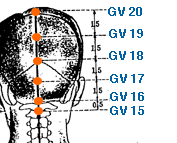GV 16
Acupuncture Point Theory
GV 16 Acupuncture Point Applications and Theory
 The acupuncture point "GV 16" , 風府, is represented by "Feng Fu" in pinyin and "Wind Mansion" in english and may be found:
The acupuncture point "GV 16" , 風府, is represented by "Feng Fu" in pinyin and "Wind Mansion" in english and may be found:
1 cun directly above the midpoint of the PHL, directly below the occipital protuberance on the posterior midline of the head.
Of many possible clinical applications, it may be considered to influence the following issues/symptoms:
- Main point for wind, whether exterior or interior, particularly affecting the head and neck. For wind cold headache, stiff neck, aversion to wind; as well as dizziness, visual dizziness, numbness, twitching, tremors.
- Window of the Sky point, promotes communication between the head and body, many indications are consistient with other points of this group, such as headache, dizziness, throat swelling, earache, eye pain, nosebleeds, aphasia.
- Psychological issues such as mania, palpitations from fear a/or fright, suicidal thoughts.
- Tong Ren/Tam Healing System: Used to effect the medulla function (breathing issues, asthma, tight chest, etc.), but GV 17 is used more frequently, useful in spinal cord issues.
GV 16 has some precautions to be considered (see our precautions list).
Avoid Moxa (MX)
No Deep Needling (NDN)
Gv 16 has the following theoretical associations which serve as important guideposts in designing an effective treatment protocol:
- Window of the Sky Point
- Sea of Marrow Point (with GV 20)
- Ghost Point
- Intersecting Point of the Governing Vessel, Yang Wei Vessel & Urinary Bladder Channel
Explore gv 16 functional groupings theory - Four Seas, Sky Window and/or Ghost Point, or read all point categories and related theory.
While not necessarily valid clinically, EX Huatuojiaji at C1 (C1 innervates the top of the head and is an impor…) and UB 10 (Relieves pain - neck issues, stiffness, ROM, occi…) are nearby.
All Content 1999-2025
Chad J. Dupuis / Yin Yang House
Our Policies and Privacy Guidelines
Our Affiliated Clinics
